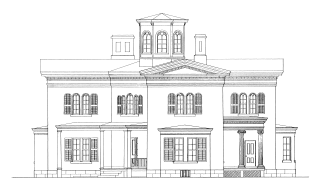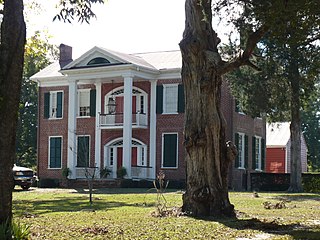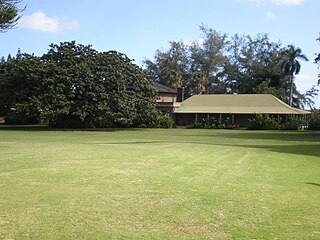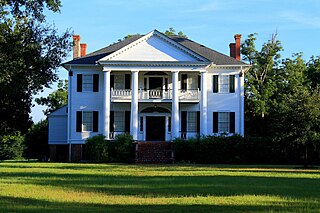
Berkeley Plantation, one of the first plantations in America, comprises about 1,000 acres (400 ha) on the banks of the James River on State Route 5 in Charles City County, Virginia. Berkeley Plantation was originally called Berkeley Hundred and named after the Berkeley Company of England. In 1726, Benjamin Harrison IV built on the estate one of the first three-story brick mansions in Virginia. It is the ancestral home to two presidents of the United States: William Henry Harrison, and his grandson Benjamin Harrison. It is now a museum property, open to the public.

Sevierville is a city in and the county seat of Sevier County, Tennessee, located in eastern Tennessee. The population was 14,807 at the 2010 United States Census and 17,117 according to the 2019 census estimate.

Cooleemee, also known as the Cooleemee Plantation House, is a house located between Mocksville and Lexington, North Carolina, at the terminus of SR 1812 on the Yadkin River in Davie County, North Carolina. It is a U.S. National Historic Landmark, designated in 1978 for its architecture.

This is a list of the National Register of Historic Places listings in Wilcox County, Alabama.

The Forks of Cypress was a large forced-labor cotton farm and Greek Revival plantation house near Florence in Lauderdale County, Alabama. It was designed by architect William Nichols for James Jackson and his wife, Sally Moore Jackson. Construction was completed in 1830. It was the only Greek Revival house in Alabama with a two-story colonnade around the entire house, composed of 24 Ionic columns. The name was derived from the fact that Big Cypress Creek and Little Cypress Creek border the plantation and converge near the site of the main house. Although the main house was destroyed by fire in 1966 after being struck by lightning, the site was placed on the Alabama Register of Landmarks and Heritage on April 14, 1992 and the National Register of Historic Places on October 10, 1997. The site is the property of the State of Alabama; a local board has oversight.

Middleburg Plantation is a historic colonial-era plantation on the Cooper River near Huger, South Carolina. The plantation house, built in 1697 by the French Huguenot Benjamin Simons, is probably the oldest standing wood-frame building in South Carolina, and is consequently an architecturally important example of period construction. It was declared a National Historic Landmark in 1970.

Bremo, also known as Bremo Plantation or Bremo Historic District, is a plantation estate covering over 1,500 acres (610 ha) on the west side of Bremo Bluff in Fluvanna County, Virginia. The plantation includes three separate estates, all created in the 19th century by the planter, soldier, and reformer John Hartwell Cocke on his family's 1725 land grant. The large neo-palladian mansion at "Upper" Bremo was designed by Cocke in consultation with John Neilson, a master joiner for Thomas Jefferson's Monticello. The Historic District also includes two smaller residences known as Lower Bremo and Bremo Recess.

Prestwould is a historic house near Clarksville, Virginia. It is the most intact and best documented plantation surviving in Southside Virginia. The house was built by Sir Peyton Skipwith, 7th Baronet Skipwith, who moved his family from his Elm Hill Plantation to Prestwould in 1797. It was declared a National Historic Landmark in 2003. It is located on the north side of the Roanoke River, 1-mile (1.6 km) inland, approximately 6 miles (9.7 km) southwest of the intersection of Route 15 and Route 701, and approximately one mile north of Clarksville's town limits. Now a museum property, it is open for tours from April to October, or by appointment.

The William King Beck House, also known as River Bluff Plantation, is a historic plantation house on the Alabama River near Camden, Alabama. The main house was built in 1845 for William King Beck and is attributed to architect Alexander J. Bragg. William King Beck was an attorney from North Carolina who migrated to Wilcox County in the 1820s. He was the nephew of William Rufus King, the 13th Vice President of the United States.

Liberty Hall, also known as John Robert McDowell Place, is a historic plantation house near Camden, Alabama. The two-story Greek Revival style main house was built in 1855 for John Robert McDowell by W.W. Robinson. The two-story front portico features two central Ionic columns flanked by a square column to each side, reminiscent of a distyle-in-antis arrangement. The floor plan is centered on a broad hall that separates four large, equally proportioned rooms on both levels. The formal rooms and hall on the lower level have elaborate plasterwork that was designed, in part, by Harriet McDowell, wife of John Robert McDowell. The house is currently owned by the great-granddaughter of the original owner. It was added to the National Register of Historic Places on January 5, 1984.

The Tristram Bethea House, also known as Pleasant Ridge, is a historic plantation house in Canton Bend, Alabama. The two-story brick house was built in 1842 in the Federal style. It was added to the National Register of Historic Places on July 11, 1985.

Coy is an unincorporated community in Wilcox County, Alabama, United States. Coy is located in a bend of the Alabama River and is home to several historic plantations. The most notable of these is Dry Fork Plantation, included on the National Register of Historic Places.

The Tait–Ervin House, also known as Countryside, is a historic plantation house near Camden, Alabama. The two-story wood-frame house was built in 1855 for Robert Tait by a builder named Henry Cook. Robert was the grandson of Charles Tait, a United States Senator from Georgia. The plantation was acquired after the American Civil War by Robert Tait's sister, Sarah Asbury Tait Ervin, and her husband, Dr. Robert Hugh Ervin. Dr. Ervin served in both houses of the Alabama Legislature and was elected President Pro Tem of the state senate in 1872. The house remained in the Ervin family until 1991, when it was sold to the Phillipi family. The house was added to the National Register of Historic Places on February 24, 1995.

The Hawthorne House, also known as the Col. J. R. Hawthorne House, is a historic plantation house in Pine Apple, Alabama, USA. The two-story wood-frame house was built in 1854 for Joseph Richard Hawthorne by Ezra Plumb. Joseph Hawthorne was born in 1805 in North Carolina, but the family had relocated to Wilkinson County, Georgia by 1810. Hawthorne moved to Conecuh County, Alabama in the 1830s and finally settled in Pine Apple in the 1850s. He owned several large plantations in Conecuh and Wilcox counties. He died in Pine Apple in 1889. The house was sold out of the family after his death, but was brought back into the family when acquired in 1935 by Gladys Hawthorne Whitaker and her brother, Dr. Julian Hawthorne, a New York physician. They restored the house and it remained in the family until Mrs. Whitaker's death in 1980. The house was recorded by the Historic American Buildings Survey in 1937. It was purchased after the death of Mrs. Whitaker by Dr. Edward Childs of Mobile. The house was added to the Alabama Register of Landmarks and Heritage on November 9, 1992, and to the National Register of Historic Places on March 7, 1985, with the name of Hawtorn House.

Rosemount is a historic plantation house near Forkland, Alabama. The Greek Revival style house was built in stages between 1832 and the 1850s by the Glover family. The house has been called the "Grand Mansion of Alabama." The property was added to the National Register of Historic Places on May 27, 1971. The Glover family enslaved over 300 people from 1830 until 1860.

The Shadow Mountain Lookout, also known as the Shadow Mountain Patrol Cabin, was built in Rocky Mountain National Park in 1932, to the design of the National Park Service San Francisco Landscape Architecture Division. It was regarded as one of the best National Park Service Rustic buildings in the national park system. It is now the only fire lookout surviving in Rocky Mountain National Park. Three other lookouts, now gone, were located at Twin Sisters Peak, the north fork of the Thompson River and near Long's Peak. The lookout was built by Civilian Conservation Corps labor.

Grove Farm is a historic agricultural site on Kauai in the Hawaiian Islands.

Youpon Plantation, originally known as Mimosa and also known as the Mathews-Tait-Rutherford House, is a historic antebellum plantation house and complex near Canton Bend, Alabama, United States. The three story Greek Revival-style plantation house was completed in 1848. It was extensively recorded by the Historic American Buildings Survey in 1936 and 1937. It was named for the Yaupon holly trees that were once a prominent feature of the front grounds. Architectural historians at the Alabama Historical Commission consider it to be among the most notable of the "stately pillared houses" in Alabama.

Point of Fork Plantation is a historic plantation house and farm located near Columbia, Fluvanna County, Virginia. The main house was built about 1830, and is a two-story, five bay, brick dwelling in the Greek Revival style. It measures 50 feet by 40 feet and is topped by a shallow hipped roof with balustrade. The front facade features a large two-story tetrastyle Greek Doric order portico. Also on the property are a contributing servant's house and office. The house is a twin of Glen Arvon, as they were built by brothers William and James Galt. In March 1865, Federal troops under General Philip Sheridan occupied the plantation and Sheridan set up headquarters in the house.





















